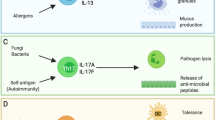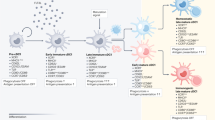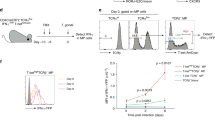Abstract
After homing to lymph nodes, CD8+ T cells are primed by dendritic cells (DCs) in three phases. During phase one, T cells undergo brief serial contacts with DCs for several hours, whereas phase two is characterized by stable T cell–DC interactions. We show here that the duration of phase one and T cell activation kinetics correlated inversely with the number of complexes of cognate peptide and major histocompatibility complex (pMHC) per DC and with the density of antigen-presenting DCs per lymph node. Very few pMHC complexes were necessary for the induction of full-fledged T cell activation and effector differentiation. However, neither T cell activation nor transition to phase two occurred below a threshold antigen dose determined in part by pMHC stability. Thus, phase one permits T cells to make integrated 'measurements' of antigen dose that determine subsequent T cell participation in immune responses.
This is a preview of subscription content, access via your institution
Access options
Subscribe to this journal
Receive 12 print issues and online access
$209.00 per year
only $17.42 per issue
Buy this article
- Purchase on SpringerLink
- Instant access to full article PDF
Prices may be subject to local taxes which are calculated during checkout








Similar content being viewed by others
References
von Andrian, U.H. & Mempel, T.R. Homing and cellular traffic in lymph nodes. Nat. Rev. Immunol. 3, 867–878 (2003).
Casrouge, A. et al. Size estimate of the αβ TCR repertoire of naive mouse splenocytes. J. Immunol. 164, 5782–5787 (2000).
Blattman, J.N. et al. Estimating the precursor frequency of naive antigen-specific CD8 T cells. J. Exp. Med. 195, 657–664 (2002).
Greenwald, R.J., Freeman, G.J. & Sharpe, A.H. The B7 family revisited. Annu. Rev. Immunol. 23, 515–548 (2005).
Haring, J.S., Badovinac, V.P. & Harty, J.T. Inflaming the CD8+ T cell response. Immunity 25, 19–29 (2006).
Henrickson, S.E. & von Andrian, U.H. Single-cell dynamics of T-cell priming. Curr. Opin. Immunol. 19, 249–258 (2007).
Halin, C. et al. The S1P-analog FTY720 differentially modulates T-cell homing via HEV: T-cell-expressed S1P1 amplifies integrin activation in peripheral lymph nodes but not in Peyer patches. Blood 106, 1314–1322 (2005).
Shiow, L.R. et al. CD69 acts downstream of interferon-α/β to inhibit S1P1 and lymphocyte egress from lymphoid organs. Nature 440, 540–544 (2006).
Weninger, W., Crowley, M.A., Manjunath, N. & von Andrian, U.H. Migratory properties of naive, effector, and memory CD8+ T cells. J. Exp. Med. 194, 953–966 (2001).
Rees, W. et al. An inverse relationship between T cell receptor affinity and antigen dose during CD4+ T cell responses in vivo and in vitro. Proc. Natl. Acad. Sci. USA 96, 9781–9786 (1999).
Holler, P.D. & Kranz, D.M. Quantitative analysis of the contribution of TCR/pepMHC affinity and CD8 to T cell activation. Immunity 18, 255–264 (2003).
Trombetta, E.S. & Mellman, I. Cell biology of antigen processing in vitro and in vivo. Annu. Rev. Immunol. 23, 975–1028 (2005).
Miller, M.J., Wei, S.H., Parker, I. & Cahalan, M.D. Two-photon imaging of lymphocyte motility and antigen response in intact lymph node. Science 296, 1869–1873 (2002).
Stoll, S., Delon, J., Brotz, T.M. & Germain, R.N. Dynamic imaging of T cell-dendritic cell interactions in lymph nodes. Science 296, 1873–1876 (2002).
Bousso, P. & Robey, E. Dynamics of CD8+ T cell priming by dendritic cells in intact lymph nodes. Nat. Immunol. 4, 579–585 (2003).
Mempel, T.R., Henrickson, S.E. & von Andrian, U.H. T-cell priming by dendritic cells in lymph nodes occurs in three distinct phases. Nature 427, 154–159 (2004).
Mempel, T.R., Scimone, M.L., Mora, J.R. & von Andrian, U.H. In vivo imaging of leukocyte trafficking in blood vessels and tissues. Curr. Opin. Immunol. 16, 406–417 (2004).
Dustin, M.L., Bromley, S.K., Zhengyan, K., Peterson, D.A. & Unanue, E.R. Antigen receptor engagement delivers a stop signal to migrating T lymphocytes. Proc. Natl. Acad. Sci. USA 94, 3909–3913 (1997).
Gunzer, M. et al. Antigen presentation in extracellular matrix: interactions of T cells with dendritic cells are dynamic, short lived, and sequential. Immunity 13, 323–332 (2000).
Hugues, S. et al. Distinct T cell dynamics in lymph nodes during the induction of tolerance and immunity. Nat. Immunol. 5, 1235–1242 (2004).
Miller, M.J., Safrina, O., Parker, I. & Cahalan, M.D. Imaging the single cell dynamics of CD4+ T cell activation by dendritic cells in lymph nodes. J. Exp. Med. 200, 847–856 (2004).
Shakhar, G. et al. Stable T cell–dendritic cell interactions precede the development of both tolerance and immunity in vivo. Nat. Immunol. 6, 707–714 (2005).
Bonifaz, L. et al. Efficient targeting of protein antigen to the dendritic cell receptor DEC-205 in the steady state leads to antigen presentation on major histocompatibility complex class I products and peripheral CD8+ T cell tolerance. J. Exp. Med. 196, 1627–1638 (2002).
Lindquist, R.L. et al. Visualizing dendritic cell networks in vivo. Nat. Immunol. 5, 1243–1250 (2004).
Pircher, H., Burki, K., Lang, R., Hengartner, H. & Zinkernagel, R.M. Tolerance induction in double specific T-cell receptor transgenic mice varies with antigen. Nature 342, 559–561 (1989).
Achour, A. et al. A structural basis for LCMV immune evasion: subversion of H-2Db and H-2Kb presentation of gp33 revealed by comparative crystal structure analyses. Immunity 17, 757–768 (2002).
Puglielli, M.T. et al. In vivo selection of a lymphocytic choriomeningitis virus variant that affects recognition of the GP33–43 epitope by H-2Db but not H-2Kb. J. Virol. 75, 5099–5107 (2001).
Boulter, J.M. et al. Potent T cell agonism mediated by a very rapid TCR/pMHC interaction. Eur. J. Immunol. 37, 798–806 (2007).
Zhu, X. et al. Visualization of p53(264–272)/HLA-A*0201 complexes naturally presented on tumor cell surface by a multimeric soluble single-chain T cell receptor. J. Immunol. 176, 3223–3232 (2006).
Unternaehrer, J.J., Chow, A., Pypaert, M., Inaba, K. & Mellman, I. The tetraspanin CD9 mediates lateral association of MHC class II molecules on the dendritic cell surface. Proc. Natl. Acad. Sci. USA 104, 234–239 (2007).
Worbs, T., Mempel, T.R., Bolter, J., von Andrian, U.H. & Forster, R. CCR7 ligands stimulate the intranodal motility of T lymphocytes in vivo. J. Exp. Med. 204, 489–495 (2007).
Sykulev, Y. et al. Kinetics and affinity of reactions between an antigen-specific T cell receptor and peptide-MHC complexes. Immunity 1, 15–22 (1994).
Castellino, F. et al. Chemokines enhance immunity by guiding naive CD8+ T cells to sites of CD4+ T cell-dendritic cell interaction. Nature 440, 890–895 (2006).
Kedl, R.M. et al. T cells compete for access to antigen-bearing antigen-presenting cells. J. Exp. Med. 192, 1105–1113 (2000).
Garcia, Z. et al. Competition for antigen determines the stability of T cell-dendritic cell interactions during clonal expansion. Proc. Natl. Acad. Sci. USA 104, 4553–4558 (2007).
Hogquist, K.A. et al. T cell receptor antagonist peptides induce positive selection. Cell 76, 17–27 (1994).
Li, Q.J. et al. CD4 enhances T cell sensitivity to antigen by coordinating Lck accumulation at the immunological synapse. Nat. Immunol. 5, 791–799 (2004).
Schneider, H. et al. Reversal of the TCR stop signal by CTLA-4. Science 313, 1972–1975 (2006).
Skokos, D. et al. Peptide-MHC potency governs dynamic interactions between T cells and dendritic cells in lymph nodes. Nat. Immunol. 8, 835–844 (2007).
Davis, M.M. et al. T cells as a self-referential, sensory organ. Annu. Rev. Immunol. 25, 681–695 (2007).
Purbhoo, M.A., Irvine, D.J., Huppa, J.B. & Davis, M.M. T cell killing does not require the formation of a stable mature immunological synapse. Nat. Immunol. 5, 524–530 (2004).
Irvine, D.J., Purbhoo, M.A., Krogsgaard, M. & Davis, M.M. Direct observation of ligand recognition by T cells. Nature 419, 845–849 (2002).
Sykulev, Y., Joo, M., Vturina, I., Tsomides, T.J. & Eisen, H.N. Evidence that a single peptide-MHC complex on a target cell can elicit a cytolytic T cell response. Immunity 4, 565–571 (1996).
de Baey, A. & Lanzavecchia, A. The role of aquaporins in dendritic cell macropinocytosis. J. Exp. Med. 191, 743–748 (2000).
Sims, T.N. et al. Opposing effects of PKC-θ and WASp on symmetry breaking and relocation of the immunological synapse. Cell 129, 773–785 (2007).
Campi, G., Varma, R. & Dustin, M.L. Actin and agonist MHC-peptide complex-dependent T cell receptor microclusters as scaffolds for signaling. J. Exp. Med. 202, 1031–1036 (2005).
Yokosuka, T. et al. Newly generated T cell receptor microclusters initiate and sustain T cell activation by recruitment of Zap70 and SLP-76. Nat. Immunol. 6, 1253–1262 (2005).
Heath, W.R. et al. Cross-presentation, dendritic cell subsets, and the generation of immunity to cellular antigens. Immunol. Rev. 199, 9–26 (2004).
Monu, N. & Trombetta, E.S. Cross-talk between the endocytic pathway and the endoplasmic reticulum in cross-presentation by MHC class I molecules. Curr. Opin. Immunol. 19, 66–72 (2007).
Wei, S.H. et al. Ca2+ Signals in CD4+ T cells during early contacts with antigen-bearing dendritic cells in lymph node. J. Immunol. 179, 1586–1594 (2007).
Wulfing, C. et al. Costimulation and endogenous MHC ligands contribute to T cell recognition. Nat. Immunol. 3, 42–47 (2002).
Mora, J.R. et al. Selective imprinting of gut-homing T cells by Peyer's patch dendritic cells. Nature 424, 88–93 (2003).
Manning, L.S. et al. A model of multiple myeloma: culture of 5T33 murine myeloma cells and evaluation of tumorigenicity in the C57BL/KaLwRij mouse. Br. J. Cancer 66, 1088–1093 (1992).
Liu, L.B. et al. Peptide-loading enhancement for antigen presenting cells. J. Immunol. 178, 93.6 (2007).
Acknowledgements
We thank T. Buschman for assistance with programming; M. van den Broek for providing cDNA constructs for the P14 TCR; and G. C heng and J. Alton for technical and secretarial assistance, respectively. Supported by the National Institutes of Health (AI069259 and AI072252 to U.H.v.A.; HL07623 and Medical Scientist Training Program to S.E.H.; HL066987 to T.R.M.; PO1 AI071195-01 for H.Z., M.N.A. and A.K.C.).
Author information
Authors and Affiliations
Contributions
S.E.H. designed the study, did and analyzed experiments, and wrote the manuscript; U.H.v.A designed the study and wrote the manuscript; T.R.M., I.B.M., A.P., M.P.F., B.S. and T.J. did experiments; B.L. and H.C.W. provided reagents; and M.N.A., H.Z. and A.K.C. modeled the experimental data.
Corresponding author
Ethics declarations
Competing interests
H.C.W. is president and CEO of Altor BioScience and B.L. is a senior scientist at Altor Bioscience.
Supplementary information
Supplementary Text and Figures
Supplementary Figures 1–3 and Methods (PDF 1676 kb)
Supplementary Video 1
Phase one with high dose C-peptide. Antigen-specific P14 T cells (green) and control OT-I T cells (blue) interacted with 10μM C-peptide pulsed CD11c+ DCs (red). The peptide-pulsed DCs (20μM CMTMR) were injected with 10ng LPS into the footpad of a recipient C57BL6 mouse. 18 hours later, P14 CD8+ T cells (2.5μM CMFDA, green) and control, OT-I CD8+ T cells (10μM CMAC, blue) were injected i.v. followed 2h later by 100mg Mel-14 antibody i.v. Images were collected from 2.5-3.5h after T cell transfer by MPM-IVM of the right popliteal LN in an anesthetized mouse in the z dimension over a distance of 40μm. Bar = 10μm. (MOV 7727 kb)
Supplementary Video 2
Early phase two with high dose M-peptide. (MOV 8663 kb)
Antigen-specific P14 T cells (green) and control OT-I T cells (blue) interacted with 10μM M-peptide pulsed CD11c+ DCs (red). The peptide-pulsed DCs (20μM CMTMR) were injected with 10ng LPS into the footpad of a recipient C57BL6 mouse. 18 hours later, P14 CD8+ T cells (2.5μM CMFDA, green) and control, OT-I CD8+ T cells (10μM CMAC, blue) were injected i.v. followed 2h later by 100μg Mel-14 antibody i.v.. Images were collected from 2.5-3.5h after T cell transfer by MPM-IVM of the right popliteal LN in an anesthetized mouse in the z dimension over a distance of 40μm. Bar = 10μm.
Supplementary Video 3
Phase one with a sub-threshold dose of M-peptide. (MOV 8229 kb)
Antigen-specific P14 T cells (green) and control OT-I T cells (blue) interacted with 100pM M-peptide pulsed CD11c+ DCs (red). The peptide-pulsed DCs (20μM CMTMR) were injected with 10ng LPS into the footpad of a recipient C57BL6 mouse. 18 hours later, P14 CD8+ T cells (2.5μM CMFDA, green) and control, OT-I CD8+ T cells (10μM CMAC, blue) were injected i.v. followed 2h later by 100μg Mel-14 antibody i.v.. Images were collected from 2.5-3.5h after T cell transfer by MPM-IVM of the right popliteal LN in an anesthetized mouse in the z dimension over a distance of 40μm. Bar = 10μm.
Supplementary Video 4
Prolonged phase one with a threshold dose of M-peptide. (MOV 8624 kb)
Antigen-specific P14 T cells (green) and control OT-I T cells (blue) interacted with 200pM M-peptide pulsed CD11c+ DCs (red). The peptide-pulsed DCs (20μM CMTMR) were injected with 10ng LPS into the footpad of a recipient C57BL6 mouse. 18 hours later, P14 CD8+ T cells (2.5μM CMFDA, green) and control, OT-I CD8+ T cells (10μM CMAC, blue) were injected i.v. followed 2h later by 100mg Mel-14 antibody i.v.. Images were collected from 2.5-3.5h after T cell transfer by MPM-IVM of the right popliteal LN in an anesthetized mouse in the z dimension over a distance of 40μm. Bar = 10μm.
Supplementary Video 5
Late phase two with a threshold dose of M-peptide. (MOV 8829 kb)
Antigen-specific P14 T cells (green) and control OT-I T cells (blue) interacted with 200pM M-peptide pulsed CD11c+ DCs (red). The peptide-pulsed DCs (20μM CMTMR) were injected with 10ng LPS into the footpad of a recipient C57BL6 mouse. 18 hours later, P14 CD8+ T cells (2.5μM CMFDA, green) and control, OT-I CD8+ T cells (10μM CMAC, blue) were injected i.v. followed 2h later by 100mg Mel-14 antibody i.v.. Images were collected from 6.5-7.5h after T cell transfer by MPM-IVM of the right popliteal LN in an anesthetized mouse in the z dimension over a distance of 40μm. Bar = 10μm.
Supplementary Video 6
Early phase two with very high dose C-peptide.Antigen-specific P14 T cells (green) and control OT-I T cells (blue) interacted with 100μM C-peptide pulsed CD11c+ DCs (red). The peptide-pulsed DCs (20μM CMTMR) were injected with 10ng LPS into the footpad of a recipient C57BL6 mouse. 18 hours later, P14 CD8+ T cells (2.5μM CMFDA, green) and control, OT-I CD8+ T cells (10μM CMAC, blue) were injected i.v. followed 2h later by 100mg Mel-14 antibody i.v.. Images were collected from 4-5h after T cell transfer by MPM-IVM of the right popliteal LN in an anesthetized mouse in the z dimension over a distance of 40μm. Bar = 10μm. (MOV 7933 kb)
Supplementary Video 7
Earlier phase two for P14 interacting with two populations of DCs pulsed with different levels of M-peptide. (MOV 6674 kb)
Antigen-specific P14 T cells (green) interacted with two populations of peptide pulsed CD11c+ DCs (red: 200pM M-peptide, blue: 10μM M-peptide). The peptide-pulsed DCs (red, 20μM CMTMR and blue, 10μM CMAC) were injected with 10ng LPS into the footpad of a recipient C57BL6 mouse. 18 hours later, P14 CD8+ T cells (2.5μM CMFDA) were injected i.v. followed 2h later by 100mg Mel-14 antibody i.v.. Images were collected from 4-5h after T cell transfer by MPM-IVM of the right popliteal LN in an anesthetized mouse in the z dimension over a distance of 40μm. Bar = 10μm.
Supplementary Video 8
Phase one for P14 T cells and phase two for OT-I T cells interacting with dually peptide pulsed DCs. (MOV 6035 kb)
Antigen-specific P14 T cells (green) and control OT-I T cells (blue) interacted with dually peptide pulsed CD11c+ DCs (red, 200pM M-peptide and 10μM SIINFEKL). The peptide-pulsed DCs (20μM CMTMR) were injected with 10ng LPS into the footpad of a recipient C57BL6 mouse. 18 hours later, P14 CD8+ T cells (2.5μM CMFDA, green) and control, OT-I CD8+ T cells (10μM CMAC, blue) were injected i.v. followed 2h later by 100mg Mel-14 antibody i.v.. Images were collected from 3.5-4.5h after T cell transfer by MPM-IVM of the right popliteal LN in an anesthetized mouse in the z dimension over a distance of 40μm. Bar = 10μm.
Supplementary Video 9
Phase two for both P14 T cells and OT-I T cells interacting with dually peptide pulsed DCs. (MOV 8650 kb)
Antigen-specific P14 T cells (green) and control OT-I T cells (blue) interacted with dually peptide pulsed CD11c+ DCs (red, 10nM M-peptide and 10μM SIINFEKL). The peptide-pulsed DCs (20μM CMTMR) were injected with 10ng LPS into the footpad of a recipient C57BL6 mouse. 18 hours later, P14 CD8+ T cells (2.5μM CMFDA, green) and control, OT-I CD8+ T cells (10μM CMAC, blue) were injected i.v. followed 2h later by 100mg Mel-14 antibody i.v.. Images were collected from 2.5-3.5h after T cell transfer by MPM-IVM of the right popliteal LN in an anesthetized mouse in the z dimension over a distance of 40μm. Bar = 10μm.
Rights and permissions
About this article
Cite this article
Henrickson, S., Mempel, T., Mazo, I. et al. T cell sensing of antigen dose governs interactive behavior with dendritic cells and sets a threshold for T cell activation. Nat Immunol 9, 282–291 (2008). https://doi.org/10.1038/ni1559
Received:
Accepted:
Published:
Issue Date:
DOI: https://doi.org/10.1038/ni1559



